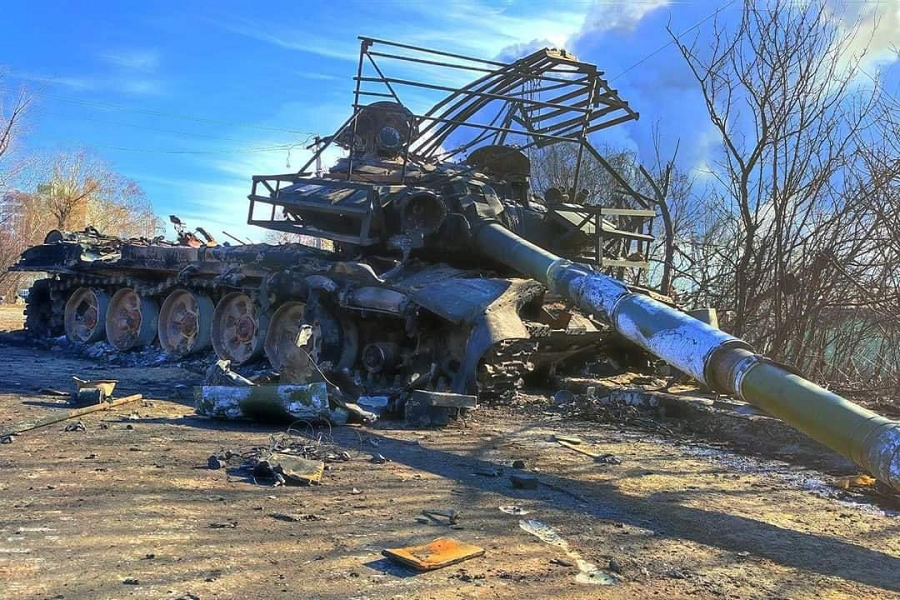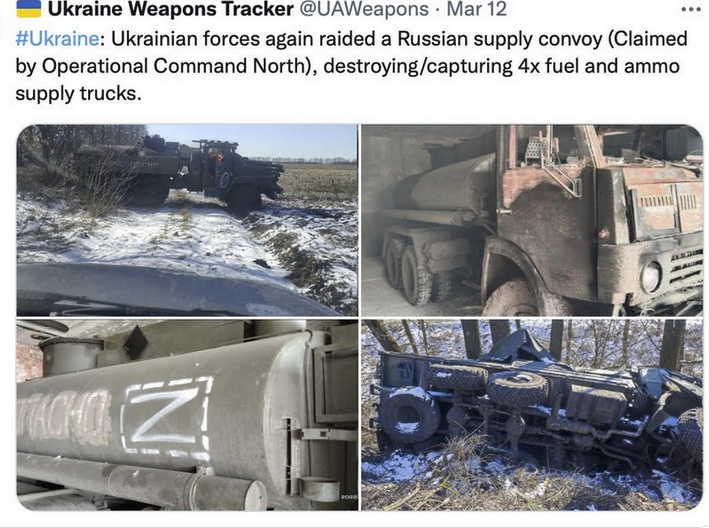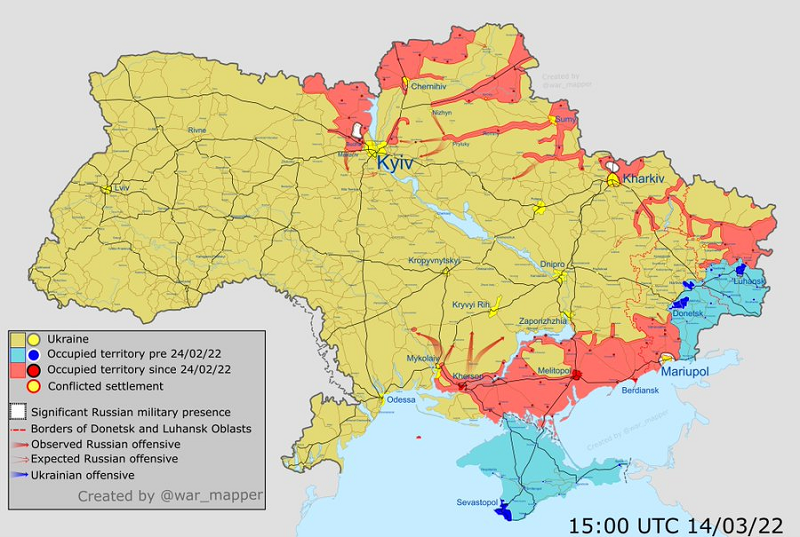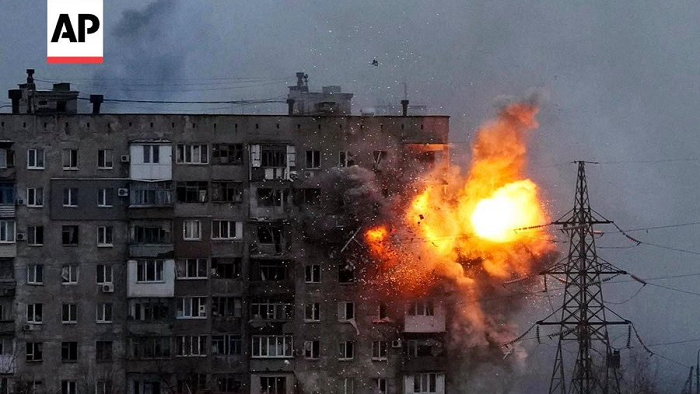THE CULMINATION OF RUSSIA’S DEFEAT IN UKRAINE?
 [Generals Ryan and Hodges provide their professional assessment of how and why Russia is losing its military attempt to conquer and subjugate Ukraine. Gen. Ryan gives the background to today (3/15), then Gen. Hodges explains why “the next ten days may decide this war.”]
[Generals Ryan and Hodges provide their professional assessment of how and why Russia is losing its military attempt to conquer and subjugate Ukraine. Gen. Ryan gives the background to today (3/15), then Gen. Hodges explains why “the next ten days may decide this war.”]
General Ryan:
Experienced Russia observers were saying as early as 2017 that the power of the Russian military was overestimated, it was challenged by overstretch, and was technologically backward. These observers have been proved right.
Russia committed around 55% of their total regular ground forces to their invasion of Ukraine. It was tactical risk. While there are forces still in Russia for reinforcements, they are either on other missions, in training, or of a lower quality (especially their reserves).
It is also a strategic risk. Russia has deployed a large proportion of its ground combat power on a single mission that it hoped would be over quickly. This was not a calculated risk by the Russians; it was a gamble. There is a big difference between the two in military ops.
Plan A was the ‘fast, cheap and easy’ campaign plan. Use light and airborne forces to seize Kyiv and other key points, capture government leaders and force a political accommodation from Ukraine. Within 48 hours, combat losses indicated to Russian commanders this had failed.
Therefore they needed a Plan B without a massive additional injection of forces. If the Russians had been clever as many thought, they would have wargamed worst case scenarios during the build-up phase of this invasion. They clearly did not wargame – or not rigorously enough if they did. But then again, these are the same folks who have talked up concepts like ‘strategies of limited action’.
So, the Russian campaign Plan B after day 2 of the war has been ‘creeping, multi-axis attrition’. It features lots more firepower, as well as destruction of smaller cities to set an example for Kyiv. Plan B also appeared to hope the Russian Air Force eventually turns up.
Plan B has not worked out either. They have slowly gained ground, but at massive cost in personnel & equipment. At the same time, rear area security has suffered. This is obviously a trade off by the Russians so they can push forward as much combat power as possible.
But rear area security is a significant mission, and normally absorbs thousands of troops (infantry, air defense, cavalry, engineers, etc). Because the Russians have incompetently executed this mission, there have been constant ambushes against logistics convoys.
These ambushes on logistics convoys are another source of attrition in personnel, supplies and equipment to add to combat losses, and combat refusals and desertions from Russian troops.
As open source, as well as UK and US military briefs, note, the Russian advances in the north, east and south are grinding to a standstill. They have been outfought by the Ukrainians and have not been able to logistically sustain advances on multiple fronts.
Summing up, Russia has not achieved its key military objectives in the north, east or south. It is conducting concurrent offensives in different, disconnected parts of Ukraine. It has committed all the military forces it had for Ukraine on these missions.
The Russian campaign, if it has not already, is about to culminate. US doctrine defines this as (for offense) “the point at which continuing the attack is no longer possible and the force must consider reverting to a defensive posture or attempting an operational pause.”
So, the Russian high command has had to go back to drawing board (again) with their campaign design, through which commanders and their staffs sequence and orchestrate tactical goals and actions. Now we see the beginnings of Russia’s ‘Plan C’ campaign in Ukraine. It is an even more ad hoc and brutal plan that their two previous attempts. This demonstrates Putin’s frustration, the desperation of Russian military leaders, and weakness in the Russian military position.
Plan C might be described as: hold current gains, long range firepower on cities, foreign fighters as cannon fodder, destroy as much infrastructure and manufacturing capacity as possible, expand the war to the west to deter foreign volunteers and aid providers. This will permit the Russians to economize in personnel, trickle in replacements (and foreign mercenaries), while expending large amounts of cheap artillery and rockets in the hope they can terrorize Ukrainian civilians to force a political accommodation.
Russian operations have been compromised by the size of their forces committed, and force attrition. This now has strategic consequences as their campaign culminates, and adapts to be firepower-centric, resulting in mass destruction and deaths of Ukrainian civilians.
At this point, I want to give the floor to my good friend and colleague, General Ben Hodges. I concur with his assessment that The Next Ten Days Will Decide This War.
General Hodges:
The Russians are in trouble, and they know it. That’s why they have reached out to China for help and why they are now recruiting Syrians.
Russian generals are running out of time, ammunition, and manpower. That’s not based on any inside intelligence — it’s clear from open source information and my own experience. I could be way off, but I am confident of this assessment.
An essential caveat to my assessment is that we, the West, led by the US, must accelerate and expand the support we are providing to Ukraine on the scale and with the sense of urgency of the Berlin Airlift (June 1948-May 1949).
Ukrainians need the weapons and ammunition to destroy the rockets, cruise missiles, and long-range artillery that are causing most of the damage to Ukrainian cities, as well as the intelligence to locate those systems, and the ability to hit Russian Navy vessels that are launching cruise missiles into cities from the Black Sea and the Azov Sea.
The time challenge for Russia is not just military. The effects of sanctions are growing — Russia may soon default on $150bn of foreign currency debt —and Russian domestic resentment is also growing (we should remember that it’s unusual as well as extremely brave for ordinary people to protest in Putin’s Russia and for television editors to suddenly interrupt their own programs waving anti-war placards.)
We should do all we can to fuel that discontent and to let courageous Russians know they have our support.
The Russians are experiencing ammunition shortages. Their transition to attrition warfare is driving up consumption rates beyond what they had planned and what they can sustain. They will still have a lot of the conventional artillery and so-called dumb bombs.
But as we know from past US military operations, the most sophisticated munitions are very expensive and so more limited in availability. The Russians are likely to be having the same experience; in addition, they thought the campaign would end within a few days so large stocks were probably not prepared.
Wartime consumption always exceeds planning numbers, and urban combat exacerbates that. Sanctions will also have assisted —Finland and Slovenia used to provide some munitions to Russia, and those have now stopped.
The Pentagon has said that 50% of Russian combat power was committed in Ukraine. At the height of our wars in Iraq and Afghanistan, we were about 29% committed. And it was difficult to sustain that.
This plays directly into the discussion of the encirclement of Kyiv. Russia does not have the manpower or firepower to encircle the Ukrainian capital of Kyiv, let alone capture it.
I have been to Kyiv several times. I was there in Kyiv five weeks ago, and met President Zelenskyy. It is a very large, dense major urban center on the banks of one of Europe’s largest rivers. It is a difficult, complex urban terrain.
The Ukrainians are going to be able to keep it open and prevent encirclement, especially if we can get the flow of weapons and ammunition up to the levels needed. There will be, unfortunately, be increasing attacks on the city by air and ground systems, and many more innocent Ukrainian citizens will be murdered, injured, or displaced. But I don’t believe it will fall.
Russia’s dilemma is only worsened by its combat casualties. Although I am always skeptical about enemy body counts, I do believe the numbers of dead are in the thousands, in the 5,000-6,000 range suggested by US sources, and the numbers of wounded much higher.
The modern battlefield is extremely lethal, especially for poorly trained or disciplined soldiers. These are very high numbers for just the first two weeks of war and many come from Russia’s elite units — they are hard to replace (and the Kremlin won’t be able to conceal these losses from the Russian public and all those for long.)
Reports of low morale, dissension between commanders, mutiny on at least one vessel, desertion, and so on, all within the first two weeks are indicators of major manpower problems. And in pure numbers, the Ukrainian armed forces still outnumber or closely match Russian forces actually on the ground in Ukraine.
There is no suggestion that the Russians have big units lurking in the woods somewhere (and the Pentagon has said it sees no signs of significant reinforcements.) So it’s apparent that the notional 900,000 strength of the Russian military is a hollow number. Their public call for 16,000 troops from Syria and elsewhere indicates this.
Employment of “stop loss” by Russia on conscripts whose time is about up is another indicator. The Ukrainian diaspora is flocking home to help the fight; Russians abroad are not coming back home — and indeed, many are leaving Russia to avoid Putin’s fight.
There is now an opportunity to exacerbate their manpower problem. The next intake of conscripts into the Russian Army is on April 1, when around 130,000 Russian families are required to send their sons (18-25) to Conscription Centers where they will be inducted into the Russian Army as privates.
We should do all we can to influence that next intake by using a combination of human outreach as well as cyber/technical means to bypass the Russian blackout on journalism and social media.
Millions of Ukrainians, Georgians, Germans, Poles, Lithuanians, Latvians, Estonians, and Finns have friends, family, business contacts, employees, and customers in Russia. They should be reaching out to them directly — Lithuanians have already launched a campaign along these lines.
If we can get some percentage of those families to resist, joining those thousands of Russians who are already showing the courage to protest, that would send shockwaves across Russia.
The next 10 days are decisive. It is a race and I’m not seeing enough urgency. We need to push the gas pedal to the floor now, immediately.
Maj. Gen. Mick Ryan is recently retired from the Australian Army as Commander of the Australian Defense College in Canberra.
Lieut. General (Ret.) Ben Hodges is Pershing Chair in Strategic Studies at the Center for European Policy Analysis in Washington, DC.




